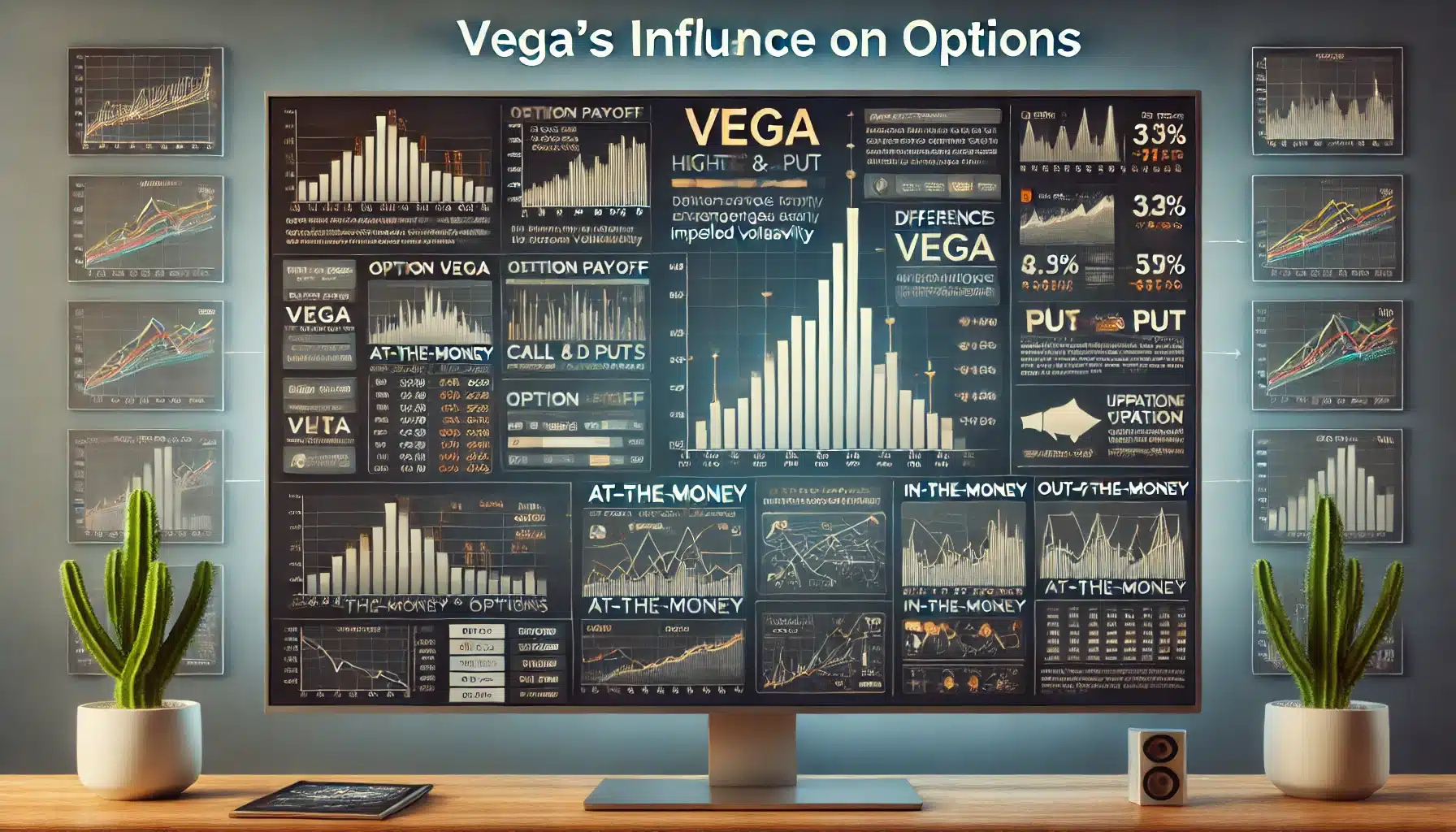Vega’s Influence on Options
Vega’s Influence on Options
Understanding How Vega Impacts Option Pricing and Volatility

Introduction
When trading options, it’s crucial to understand the factors that influence option pricing. One of the most important of these factors is “Vega,” a Greek letter used in options trading to represent the sensitivity of an option’s price to changes in the volatility of the underlying asset. Vega plays a key role in determining the value of an option, and understanding how it works can significantly improve your trading strategies. This guide will explore Vega’s influence on options, how it impacts option pricing, and how traders can use this knowledge to make more informed trading decisions.
What is Vega?
Defining Vega in Options Trading
Vega is one of the “Greeks” in options trading—a group of metrics that describe how different factors impact the price of an option. Specifically, Vega measures the change in an option’s price for each 1% change in the implied volatility of the underlying asset. Implied volatility is the market’s forecast of a likely movement in the underlying asset’s price and is a crucial component in options pricing.
Vega is not static; it fluctuates depending on several factors, including the time to expiration and the level of implied volatility itself. Understanding Vega is essential for traders who wish to gauge how sensitive an option’s price is to changes in market volatility.
How Vega is Calculated
Vega is usually expressed as a positive number and represents the amount an option’s price will increase or decrease given a 1% change in implied volatility. For example, if an option has a Vega of 0.25, and implied volatility increases by 1%, the option’s price is expected to increase by $0.25, assuming all other factors remain constant.
Vega is highest for at-the-money options and decreases as the option moves further in-the-money or out-of-the-money. Additionally, Vega tends to be higher for options with longer times to expiration, as there is more time for volatility to impact the price.
Vega’s Influence on Option Pricing
The Relationship Between Vega and Volatility
Vega directly links an option’s price to the volatility of the underlying asset. When implied volatility increases, the prices of both call and put options generally rise. This is because higher volatility increases the probability that the option will expire in-the-money, making it more valuable. Conversely, when implied volatility decreases, the prices of options tend to fall, as the likelihood of the option expiring in-the-money diminishes.
Vega is particularly significant in volatile markets. During periods of high market uncertainty, implied volatility often spikes, causing a corresponding increase in option premiums. Traders who are aware of Vega’s influence can use this to their advantage by adjusting their strategies to account for expected changes in volatility.
Vega’s Impact on Different Types of Options
Vega affects different types of options in varying ways.
Vega and At-the-Money Options
At-the-money (ATM) options, where the strike price is close to the current price of the underlying asset, have the highest Vega. This is because these options are most sensitive to changes in implied volatility. Any significant change in volatility can have a large impact on the option’s price, making Vega a critical factor for traders dealing with ATM options.
Vega and Out-of-the-Money/In-the-Money Options
Out-of-the-money (OTM) and in-the-money (ITM) options have lower Vega compared to ATM options. As options move further out-of-the-money or deeper in-the-money, their sensitivity to changes in volatility decreases. This is because the probability of these options expiring in-the-money is less affected by changes in implied volatility. Therefore, while Vega still plays a role, its influence is less pronounced for these options.
The Time Factor: How Vega Changes with Time to Expiration
Vega is not constant over the life of an option. It tends to be higher for options with more time remaining until expiration and decreases as the option approaches its expiration date. This is because there is more uncertainty about where the underlying asset’s price will be in the distant future, making volatility more significant in pricing the option. As expiration approaches, this uncertainty decreases, reducing Vega’s impact on the option’s price.
Trading Strategies Involving Vega
Trading High-Vega Options
In a market where implied volatility is expected to increase, trading options with high Vega can be beneficial. Traders might consider buying options when they anticipate a rise in volatility because the option’s price is likely to increase as a result of higher Vega. This strategy is particularly useful during earnings season or before significant economic announcements when volatility typically spikes.
Example: Buying Calls with High Vega
Suppose you anticipate that a company’s stock will experience significant price movement due to an upcoming earnings report. You buy an at-the-money call option with a high Vega. If implied volatility increases as the earnings date approaches, the option’s price will rise, allowing you to sell the option at a higher price even if the stock’s price hasn’t moved much.
Hedging with Vega
Vega can also be used as a hedging tool to protect against unfavorable changes in volatility. For example, if you hold a position that benefits from low volatility, you might sell options with high Vega to offset potential losses if volatility increases.
Example: Vega Hedging with a Vertical Spread
You own a stock and want to hedge against a potential increase in volatility. You can create a vertical spread by selling a call option with a higher strike price (and thus lower Vega) and buying a call option with a lower strike price (and higher Vega). This strategy limits your risk while still providing some upside potential if volatility increases.
Managing Vega Risk
Traders must be mindful of Vega risk, especially when holding positions in volatile markets. A sudden spike or drop in implied volatility can drastically alter the value of an option, leading to unexpected gains or losses. To manage Vega risk, traders can adjust their portfolios by balancing positions with different Vega values or using options strategies designed to neutralize volatility exposure.
Example: Reducing Vega Exposure
If you hold a large number of options with high Vega and are concerned about a potential decrease in volatility, you might sell some of these options or take a position in options with lower Vega. This reduces your overall exposure to changes in volatility, helping to stabilize your portfolio.
Practical Considerations for Using Vega
Monitoring Market Conditions
To effectively use Vega in your trading strategy, it’s important to continuously monitor market conditions and implied volatility levels. Tools such as the CBOE Volatility Index (VIX) can provide insights into overall market volatility and help you anticipate changes that could impact Vega. By staying informed, you can adjust your positions proactively to take advantage of volatility shifts.
Combining Vega with Other Greeks
While Vega is crucial for understanding how volatility impacts option pricing, it’s important to consider it alongside other Greeks, such as Delta, Gamma, and Theta. These metrics together provide a more comprehensive view of the risks and potential rewards associated with an option position. For instance, while Vega measures sensitivity to volatility, Delta measures sensitivity to price changes in the underlying asset, and Theta measures the impact of time decay. By combining these metrics, traders can develop more robust strategies that account for multiple risk factors.
Timing the Market with Vega
Vega’s influence on options is most significant during periods of high volatility or when major market events are expected. Traders can use this knowledge to time their entry and exit points more effectively. For example, buying options with high Vega before an anticipated increase in volatility can be profitable, while selling options with high Vega before a decrease in volatility can help lock in gains.
Conclusion
Vega plays a pivotal role in options trading, directly influencing how an option’s price reacts to changes in market volatility. Understanding Vega’s impact allows traders to better assess the risks and opportunities associated with different option positions. Whether you’re looking to profit from increasing volatility, hedge against potential losses, or manage Vega risk, incorporating Vega into your trading strategy is essential for making informed decisions. By monitoring market conditions, combining Vega with other Greeks, and timing your trades effectively, you can harness the power of Vega to enhance your options trading performance.
Check out our articles on:
- Introduction to Options Trading
- Mastering Butterfly Spreads
- The Power of Diagonal Spreads
- The Power of Iron Condors
- The Power of Vertical Credit Spreads
Elevate Your Trading Skills
Ready to master the intricacies of options trading? Join our exclusive community of traders for comprehensive educational resources, live trading sessions, and expert analysis. Sign up today and take your trading to the next level!
Below are the links:
To your success,

Billy Ribeiro is a renowned name in the world of financial trading, particularly for his exceptional skills in options day trading and swing trading. His unique ability to interpret price action has catapulted him to global fame, earning him the recognition of being one of the finest price action readers worldwide. His deep comprehension of the nuances of the market, coupled with his unparalleled trading acumen, are widely regarded as second to none.
Connect with us:






